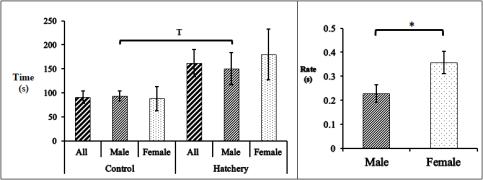Tonic immobility testing
Tonic immobility tests conducted at 5 days old

Tonic immobility testing conducted on day 5 of the experiment found that there was a tendency towards hatchery males having a longer latency until first vocalisation during tonic immobility that control males (left). There were no significant differences when comparing the hatchery group with control group, or hatchery females with control females, and when comparing males and females regardless of treatment group (p>0.1).
Analysis of vocalisation rate during tonic immobility showed a significant difference in rate of vocalisations between male and female chickens without taking treatment into account, with females vocalising at a higher rate than males (p<0.05) (right). When comparing the effect of sex within treatment groups a significant difference was found between control females and males; control females vocalised more frequently than control males (p<0.05). However no significant differences were found when comparing treatments, between control males and stressed males control females and hatchery females (p>0.1).
No significant differences were found when comparing latency until first head movement or rightening time between control and hatchery chickens, control and hatchery males, control and hatchery females, or males and females regardless of treatment (p>0.1)
Tonic immobility tests conducted at 6 weeks old

When analysing results for tonic immobility testing at 6 weeks of age hatchery males performed vocalisations at a significantly higher rate during tonic immobility than control males and hatchery females (p<0.05) (left). A tendency was also found towards control males having a longer latency to righten than hatchery males (p<0.1) (right).
There were no significant difference found for latency until first head movements and first vocalisation when comparing treatment groups, sexes within treatment groups, and sexes between treatment groups (p>0.1). No significant differences were found between control and hatchery group, control and hatchery females, males and females regardless of treatment group, and males and females within treatment groups for latency until first vocalisation (p>0.1). There were also no significant differences between control and hatchery group, control and hatchery females, males and females regardless of treatment group, and males and female control chickens for vocalisation frequency during tonic immobility (p>0.1).
Responsible for this page:
Director of undergraduate studies Biology
Last updated:
05/27/18
